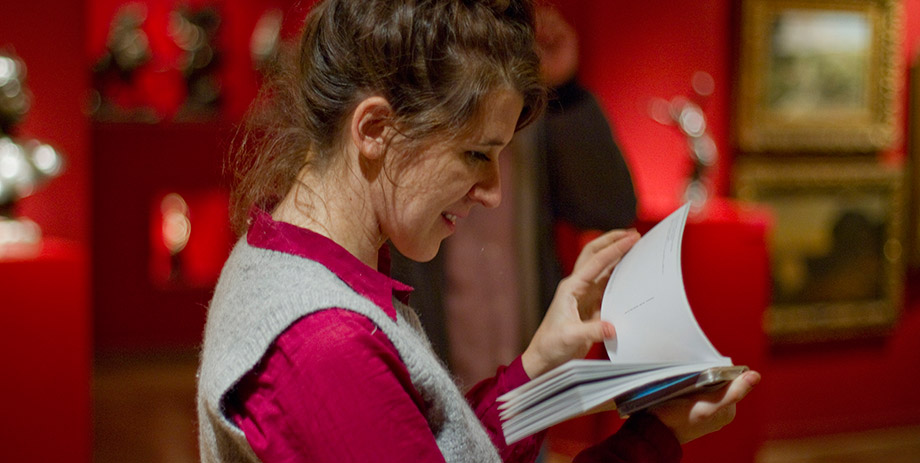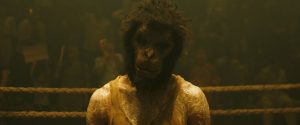Reviews include Irena’s Vow, The Beast, and Before I Change My Mind.
Platforms for Performance: A Conversation with Matías Piñeiro
September 10, 2014

By: José Teodoro
The jewel in the tiara of this year’s Wavelengths program is The Princess of France, the latest in the young Argentine director Matías Piñeiro’s ongoing project of re-envisioning of Shakespeare’s comedies. Using Love’s Labour’s Lost as a sort of collapsible template for playful yet precisely designed scenes of stolen kisses and multidisciplinary art-making, this follow-up to the internationally acclaimed Viola is taut, beguiling and mischievous. It is also a challenge to traditional distribution models, a quandary I made a point of discussing with Piñeiro when we sat down to talk about his already formidable body of work in the midst of TIFF 2014.
Piñeiro’s films are fleet, buoyant, and generally much shorter than the average, but they are also arrestingly dense with sound, image and talk. While honing his films for optimum compaction, Piñeiro is an inveterate maximalist. I think this is reflected in the transcript of our conversation, which focuses on the peculiarities of the business of his filmmaking, the pleasures and compromises of translation, the dialogue between film and theatre, and the cultural roots of Piñeiro’s gift for gab.
José Teodoro: I think about filmmakers like you or Nicolás Pereda or Denis Coté. You’re all pretty young yet have amassed a large body of work at a pace almost commeasurable with the old studio contract directors—a fairly radical revision of the proverbial maverick arthouse filmmaker toiling for years to secure finances. The current situation with international distribution has made it so that 1) no matter how widely celebrated, your films tend to screen exclusively at festivals, and 2) once you have enough films you immediately graduate to the sort of cinémathèque or museum retrospective status traditionally reserved for established masters. I don’t know how much historical precedence there is for this career model. It seems a relatively recent phenomenon.
Matías Piñeiro: That’s the true challenge. Because we’ve shown that films can be made in the manner you’ve described. It’s not a problem of generating fresh ideas—you may like them or not, but the ideas are there. It’s not a problem of writing. It’s not a problem of producing. It’s a problem of distributing and exhibiting. There’s a lack of coherence. If I’m making this number of films with this sort of a budget, with this sort of production scheme, there should be some parallel method in distribution and exhibition. It would be weird for me to use methods of distribution and exhibition that are so incongruent from my methods of production. It’s as if I’m putting on my grandma’s boots. They won’t fit. I will break them. Or maybe I won’t be able to use them at all. They reject me.
The boots?
Yes, the boots. It’s the same thing. We have to discover a new way of showing films. With my films at least, they don’t need a lot of spectators to recoup their budgets. So for me it’s not useful to make six prints, ten prints, fifteen prints, to show the films in many places just for a week, four times a day. In my city, Buenos Aires, ten years ago, fifteen years ago, this museum opened, MALBA, el Museo de arte latinoamericano de Buenos Aires, where there’s a big collection of very nice paintings and there’s also a cinema. They initially started doing retrospectives and then discovered this idea of premiering a film and showing it twice or three times a week for one month, and if it goes well they keep it on for another month. This gives my films a chance to find their audience, little by little. If I would go to the one-week thing of a regular cinema my films would be out immediately. I’m not making blockbusters or even auteur blockbusters. I’m nowhere close to doing that, so why should I submit my films to that structure? So there’s MALBA and there’s La Sala Lugones, which is our cinémathèque. Without these places we wouldn’t be making films. If you have to pile them up in your drawers or screen them only for our friends, you know, maybe you make one, two, three, but then you get discouraged. Anyway, first step is festivals. Second step, for me, in my city, is MALBA. Third step is to find places like MALBA in other countries. In Mexico I’ve found it.
La Cineteca Nacional? You had a retrospective there? That’s great.
Yes, and the films actually did okay. My standards are very small, of course, but that venue served the films well. What I’m trying to utilize now is when these festivals offer opportunities to travel, it’s not just about having drinks and cocaine, it’s about finding such places. The trick is skip over the bureaucracy of the distribution world. So far I’ve been able to do that in Mexico, in Spain, in the US. It’s a matter of being the little ant that goes from place to place, looking for your accomplices, people who, were you living in that city, would be your friends.
And it’s important to not settle for web-based models, because films like yours especially require the collective experience, the dialogue. Do they play really differently in Spanish-speaking countries, given their verbal density?
Yes, that’s a little bit of a minus. There’s a lot that we lose, but there are things that we win too. I’m learning. The Princess starts with only a black screen and a voice in Italian. For a while I wanted to cut all the subtitles, but you know what will happen, the movie will start and people will shout, “Oh, they fucked the subtitles!” So now we have part of the screen with English subtitles, part with Spanish, and it just makes sense. My films have to do with words, with translation, with talking. I’ve since come to think of subtitles not as something to consider at the end, as a subsidiary thing, but as part of the composition of the film. I had to embrace this impurity. Cinema is impure anyway.
The verbal density is in any case mirrored in every aspect of the film. Many of your individual shots provide us with visual options. You have two actors kissing in the foreground, for example, yet the lighting completely favours the painting in the background. For all the precision applied to the camera there is, as in the theatre, an variety of options as to where to look.
I don’t come from theatre, but I was asked to direct the same play that the characters are doing in The Princess, and I learned about what you’re describing. I was shooting the play for the archives of the institute that gave me this opportunity, and I started to see why that material wasn’t working, why it was badly shot theatre. I started to reconsider what cinema could learn from theatre, how to give the spectator the liberty to focus on what he wants, to focus, for example, on someone who’s not talking. In cinema we normally don’t do that, so I’m pushing a little, avoiding the straightforward, making detours. In the museum scene you mentioned, that effect was very conscious. The lighting should be for the paintings.
The effect is echoed in the scene of people dancing in the dark, with the light passing over their bodies.
Exactly. This produces a rhythm, a pace I hope the spectator can relate to.
The trajectories of your traveling shots are really distinctive. To what degree does your moving camera mimic your own gaze?
There is the freedom of looking but there is also a plan. I plan the movements because I don’t want to be distracted by, for example, a bird. I would rather stay with the planned trajectory and, instead of moving toward the bird, I want to stay with the plan and capture how the actor looks at the bird. What is she looking at? Why is she looking that way? When I saw this archival material I shot in the theatre, my camera was obviously following the words, the speakers. I was not shooting the theatre experience. I was making these close-ups. I felt bad because the actors started trying to hide the fact that this was theatre. This was also why I wanted to incorporate radio into The Princess. I wanted to take a work of theatre and place it inside a bubble, to have them do Shakespeare into a microphone, to not act it out. I like that because it’s a little bit of a distance. With that distance I can find my plot.
There’s distance but in that distance is story, as well as intimacy and character. I mentioned Nico Pareda. I don’t know how closely you follow his work but you’re both doing something interesting in your recent films by creating this distance through repetition and rehearsal, which, again, is then filled with story, intimacy, character, surprise.
Yes, I know Nico. He’s a friend. We talk about this. The films are very different. We have different personalities. But at the same time there’s something that we really share. It’s very strange. You see Greatest Hits and there is indeed this idea of repetition, of the way the film builds a plot and then abandons it, or whatever. Our films look nothing alike, but somewhere in the work we recognize each other. And he’s also working with theatre. He uses really good actors.
I’m still amazed that after more than a century few filmmakers have even scratched the surface of what cinema has to learn from theatre, which elements can be repurposed. We see it in Rivette, Fassbinder, Bergman, Pedro Costa, but it’s rare. Theatre is still a bad word. Maybe people still think of old movies in which actors play demonstratively, as if they were within a proscenium.
People are watching bad theatre. That’s the problem. When I first told people I was doing Shakespeare the collective facial reactions would have made a great documentary. They assumed I’d be doing something terrible. It’s the fault of how Shakespeare and theatre have been treated in cinema. And also the dominance of the tragedies in defining Shakespeare’s profile. I’m sure in English-speaking countries they’re more balanced with the comedies, but in my country not many people know As You Like It or Twelfth Night. I suppose that even in English-speaking countries the Elizabethan language is demanding, but I think it’s good to be demanding.
It’s demanding not only because of the Elizabethan English but also, again, because of the density of information.
Yes, when Shakespeare wants to give an example of something he gives, like, eight of them! It’s crazy.
On that note, I have this suspicion that the verbal density of your films is to some extent a reflection of either the national character, or the character of Buenos Aires, of porteños. This will sound like a horrible generalization, but man, all the porteños I know talk a lot. And, like the characters in your films, they tend to talk a lot about relationship problems. And then I learned that Argentina employs more psychiatrists per capita than any country in the world.
[Laughs] It’s true. I don’t know if it has to do with our Spanish and Italian background, with the value placed on oral exchange, on talking through everything, on family. It would be interesting to trace that. We do talk a lot. We reflect a lot. We think of ourselves as fiction, as characters in a way. Maybe it also has to do with being so far from our roots, with staying in touch, with being far away. I think it has to do with living in a big city that is so far from the other cities with which it identifies. There’s a neurosis there. But I’m glad we’re talking about it.



